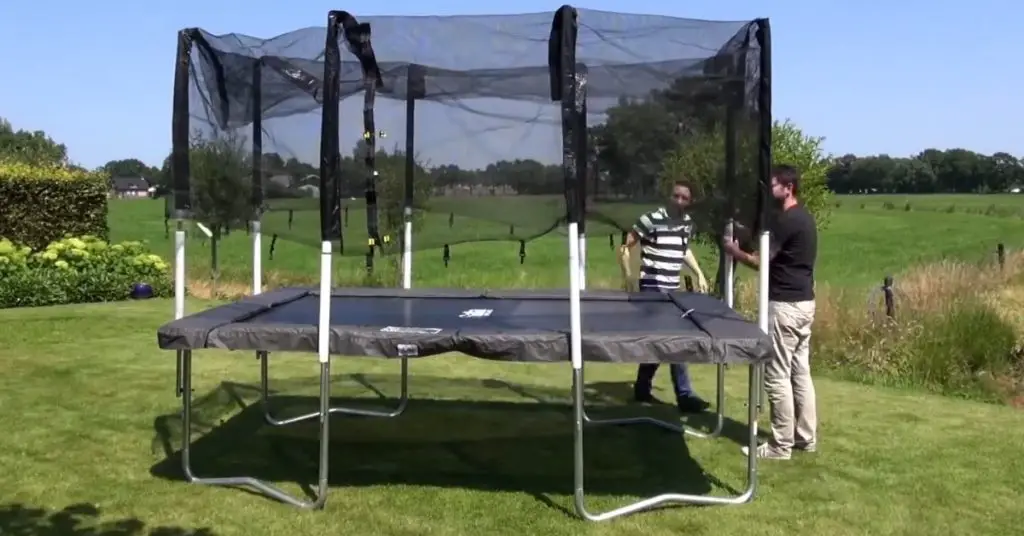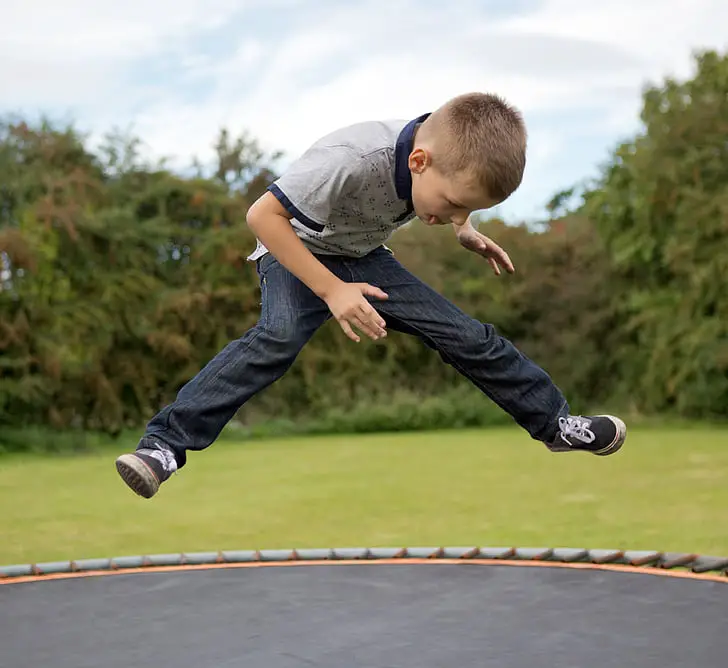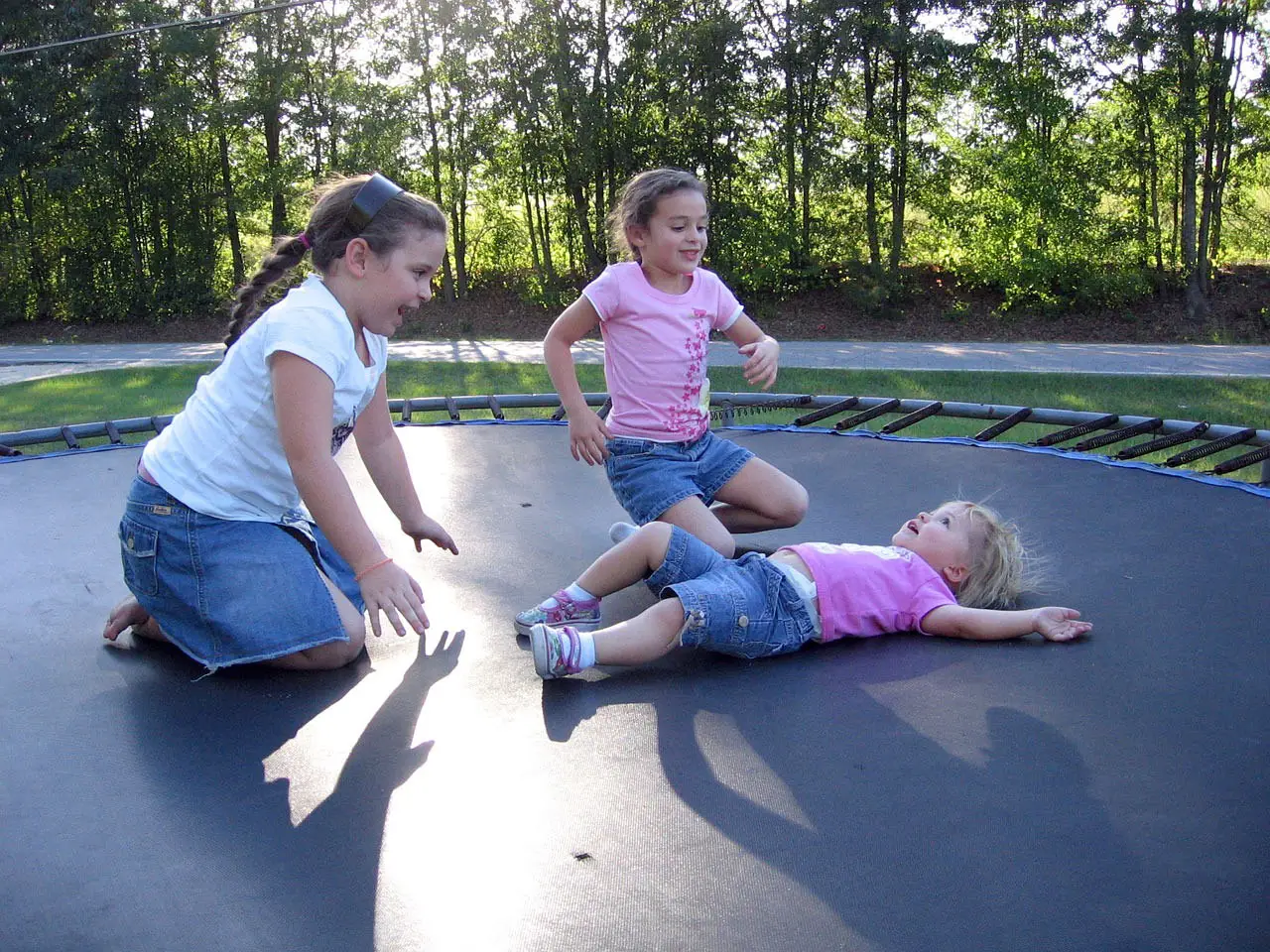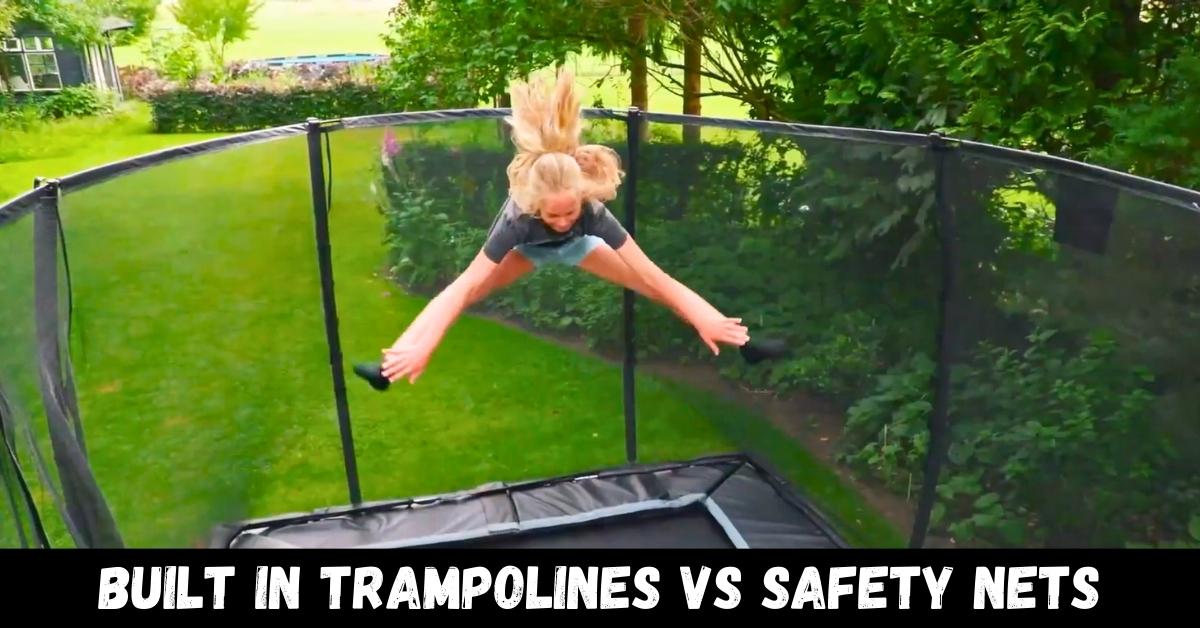Discover the ultimate showdown: built in trampolines vs safety nets. Which one will keep your family bouncing happily and safely?
Are you considering adding a trampoline to your outdoor space but unsure whether to go for a built-in option or one with a safety net? Before deciding, it’s essential to consider various factors that can impact your experience and safety.
This article aims to compare built-in trampolines and those equipped with safety nets objectively.
Regarding space and installation requirements, built-in trampolines offer the advantage of being seamlessly integrated into your outdoor area, saving valuable yard space. Safety nets, on the other hand, require additional room for setup.
When it comes to safety features and risk prevention, both options have their advantages. Built-in trampolines typically have padding around the edges, reducing the risk of injury. Safety nets provide an extra layer of protection by preventing users from falling off the trampoline.
Durability and longevity are vital considerations as well. Built-in trampolines are often sturdier due to their permanent installation, whereas safety nets may need occasional maintenance or replacement.
Choosing between a built-in trampoline and one with a safety net depends on your specific needs and preferences.
By thoroughly examining costs, bounce quality, maintenance requirements, aesthetics, accessibility, and user experience, you can decide to suit your family’s needs best while ensuring hours of safe fun on your new trampoline.
Built-In Trampolines Vs. Safety Nets: When choosing between built-in trampolines and safety nets, consider safety a top priority. Built-in trampolines offer a lower risk of falling, while safety nets add an extra layer of protection against potential accidents. Weigh the pros and cons to make the best decision for your family.
Built In Trampolines vs Safety Nets: A Comparison

Trampolines have long been a popular entertainment and physical activity source for people of all ages. Over the years, advancements in trampoline design and safety features have led to the introduction of built-in trampolines and safety nets.
Both options aim to enhance the safety of trampoline users, but they differ in their approach. To understand their benefits and considerations, let’s compare built-in trampolines and safety nets.
Space and Installation Requirements
You’ll need a large open area and proper safety precautions to set up a built-in trampoline, whereas a safety net requires less space and can be easily installed in your backyard.
Regarding space and installation requirements, built-in trampolines have larger dimensions than safety nets. They are designed to fit into the ground, requiring significant excavation work and ample room for proper installation.
On the other hand, safety nets come in compact designs that can be easily attached to existing trampolines or poles. This makes them ideal for those with limited outdoor space or who prefer a more straightforward setup process.
Additionally, built-in trampolines often have higher weight capacity due to their sturdy construction, making them suitable for older children and adults seeking an intense bouncing experience. Safety nets typically have lower weight capacities but adequately protect younger bouncers.
Safety Features and Risk Prevention
Ensure you take advantage of all the measures to minimize risks and keep yourself safe. Regarding safety features and risk prevention, both built-in trampolines and safety nets have advantages.
Built-in trampolines often come with safety regulations specifically designed to prevent injuries. These regulations can include padding around the edges of the trampoline, sturdy frames, and secure springs.
Additionally, built-in trampolines may have enclosure systems that provide an extra layer of protection by preventing users from falling off the sides.
On the other hand, safety nets offer a different approach to injury prevention. They create a physical barrier around the trampoline, preventing users from accidentally jumping off or colliding with objects outside.
Both options are crucial in ensuring your safety while enjoying this fun activity.
Durability and Longevity
Regarding durability and longevity, built-in trampolines and safety nets offer reliable options for long-lasting enjoyment.
Durability vs Safety:
- Built-in Trampolines: These are designed with sturdy materials, such as galvanized steel frames and UV-resistant jumping mats, ensuring they can withstand the test of time. They’re built to endure regular use without compromising safety.
- Safety Nets: While not as durable as built-in trampolines, safety nets protect against falls or accidents. They’re made from high-quality materials like polyethylene and are designed to prevent injuries and enhance safety.
Longevity vs. Risk Prevention:
- Built-in Trampolines: With their robust construction, built-in trampolines can last years if properly maintained. Their longevity allows families to enjoy countless hours of bouncing fun while minimizing the risk of accidents.
- Safety Nets: Although not as long-lasting as built-in trampolines, safety nets prevent injuries by providing a secure enclosure around the jumping area. This added precaution ensures users can safely enjoy their trampoline experience.
Both built-in trampolines and safety nets offer durability and longevity benefits while prioritizing user safety or risk prevention.
Cost and Budget Considerations
Considering cost and budget, both built-in trampolines and safety nets offer affordable options for families looking to enjoy the benefits of a trampoline.
When it comes to cost-effectiveness, both options have their advantages. Built-in trampolines are initially more expensive to install due to the additional construction required.
However, they require minimal maintenance and have a longer lifespan, making them an excellent long-term investment. On the other hand, safety nets are cheaper upfront but may need regular replacement or repair over time.
Regarding financial planning, families should consider their budget constraints and weigh the initial cost against potential future expenses.
It is important to note that regardless of which option you choose, proper maintenance and adherence to safety guidelines are crucial for ensuring the longevity of your trampoline investment while keeping costs in check.
Bounce Quality and Performance

The bounce on a trampoline with a built-in safety net is more secure and stable, allowing for higher jumps and smoother landings.
The safety measures during bouncing provided by the safety net protect you from falling off the trampoline, reducing the risk of injuries.
This added security lets you focus on your jumps and tricks without worrying about safety. Not only does the built-in safety net provide a safer bouncing experience, but it also positively impacts physical fitness.
Bouncing on a trampoline is an excellent exercise that improves cardiovascular health, strengthens muscles, and enhances coordination.
With the increased stability the safety net provides, you can fully engage in these activities without fear of falling or losing balance.
Opting for a trampoline with a built-in safety net ensures your physical well-being and optimal performance during bouncing sessions.
Maintenance and Upkeep
Regular maintenance and upkeep are essential to ensure the longevity and durability of your trampoline, guaranteeing continued enjoyment for years to come. Following a proper maintenance schedule can prevent costly repairs and replacements.
Here are some essential aspects of trampoline maintenance:
- Regular inspections: Check for damaged or worn-out parts such as springs, jumping mat, safety net, and frame. Addressing these issues promptly can prevent accidents and extend the lifespan of your trampoline.
- Cleaning: Regularly clean your trampoline with mild soap and water to remove dirt, debris, and stains. This will help maintain its appearance and prevent premature deterioration.
- Weather protection: During extreme weather conditions like storms or heavy snowfall, it’s crucial to protect your trampoline by removing the jumping mat or covering it properly.
- Repair and replacement costs: Remember that specific components may need repair or replacement over time due to wear and tear. Consider budgeting for these expenses to ensure your trampoline’s ongoing safety and functionality.
Following a regular maintenance routine and promptly addressing any issues, you can enjoy your trampoline safely while minimizing repair costs in the long run.
| Pros | Cons |
|---|---|
| Increased lifespan | Requires time commitment |
| Enhanced safety | Potential repair costs |
| Improved performance | Occasional replacement expenses |
| Maintains aesthetic appeal |
Aesthetics and Integration with Outdoor Space
Considering the importance of aesthetics and how well a trampoline integrates with your outdoor space, it’s essential to consider its visual appeal and how it complements your overall backyard design.
When choosing a trampoline, you want one that functions well and adds to the beauty of your surroundings. Look for designs that are sleek and modern or ones that have a classic charm, depending on your personal style preferences.
Additionally, consider how well the trampoline blends with the natural surroundings of your yard. Opt for colors and materials harmonizing with landscape elements such as trees, flowers, or hardscapes.
By carefully selecting a trampoline that matches your design and effortlessly blends with nature, you can create an inviting outdoor space that is both functional and visually appealing.
Accessibility and Ease of Use
To make your trampoline experience even more enjoyable, consider how easily accessible and user-friendly it is for you and your family.
When choosing a trampoline, it’s essential to consider the ease of assembly, portability, and storage options available. Here are some key factors to consider:
- Ease of assembly: Look for a trampoline with clear instructions and minimal parts to assemble. Some models may even have tool-free assembly options for added convenience.
- Portability: If you plan on moving or storing the trampoline frequently, look for one that’s lightweight and easy to disassemble. This will allow you to transport it without much hassle.
- Storage: Consider the space requirements when not in use. Some trampolines come with foldable frames or removable legs, making them easier to store in smaller spaces.
Considering these factors, you can ensure that your trampoline is accessible and user-friendly for everyone in your family.
Addressing a Raised Trampoline: Solutions and Safety Measures
If you have a trampoline in your yard and want to make it look nicer, there are some simple solutions. You can plant tall plants around it to partially hide the bottom and make it blend in better with the rest of your garden.
Additionally, some trampolines now come in colors that match the surroundings, like green or earth tones, making them less noticeable.
If you’re thinking of building a trampoline pit in the ground, it’s essential to hire a professional landscaper or contractor who knows how to do it correctly.
They can ensure that it drains well and allows for good bouncing. And if you decide to use a safety net, be sure to take it down when not in use to avoid accidents.
Overall, with a bit of creativity and caution, you can make your trampoline a beautiful part of your yard instead of just regular play equipment.
User Experience and Fun Factor

One factor that significantly enhances the user experience and adds an element of excitement is the inclusion of interactive features on trampolines, such as built-in LED lights or sound systems.
These features engage and interact with users, creating a more immersive and enjoyable jumping experience.
The LED lights can illuminate the trampoline surface, creating a visually stunning display that adds novelty and excitement to each jump.
Sound systems also allow users to play their favorite music while bouncing, enhancing the fun factor.
These interactive features make trampolining more engaging and provide a unique way for users to express themselves through music and light.
Whether dancing to pulsating beats or bouncing under a kaleidoscope of colors, these elements elevate the overall user experience and increase the enjoyment of using built-in trampolines.
User Age and Skill Level
Trampoline usage varies based on age and skill level. Young children and beginners require close adult supervision, safety nets, and limited tricks to reduce accidents. Older children and experienced jumpers can attempt more complex maneuvers but still need safety precautions.
Built-in trampolines with professional setups suit advanced jumpers, while safety nets with sturdy enclosures can benefit regular trampolining. Safety awareness and adherence to guidelines are essential for all age groups.
Proper supervision and safety measures are crucial to prevent injuries. Consider age-appropriate trampoline options and individual capabilities to ensure a safe and enjoyable experience for all users.
Frequently Asked Questions:
Q.1 Can a built-in trampoline be installed indoors?
Yes, a built-in trampoline can be installed indoors. Indoor trampolines provide numerous benefits, such as convenience, year-round use, and protection from weather conditions. However, following indoor trampoline safety guidelines is essential to ensure safe usage.
Q.2 Are there any safety features to prevent children from falling off the trampoline?
Safety harnesses can be used to prevent children from falling off the trampoline. These secure straps keep kids in place while they jump. Additionally, an impact-absorbing surface underneath provides cushioning and reduces the risk of injury.
Q.3 How long can a built-in trampoline typically last before needing to be replaced?
Built-in trampolines can typically last several years, depending on usage, weather conditions, and maintenance. Proper care and regular inspections can offer longevity and durability for your enjoyment.
Q.4 What is the average cost of installing a built-in trampoline compared to a safety net trampoline?
The average cost of installing a built-in trampoline is typically higher than a safety net trampoline. However, built-in trampolines are more durable and cost-effective in the long run due to their longer lifespan and lower maintenance needs.
Q.5 Does a built-in trampoline offer the same bounce quality and performance level as a safety net trampoline?
Built-in trampolines offer the same bounce quality and performance level as safety net trampolines. Both types provide a secure and enjoyable jumping experience, ensuring safety while maintaining excellent bounce capabilities.
Conclusion:
In conclusion, when choosing between built-in trampolines and safety nets, there are several factors to consider.
Both options have their advantages and drawbacks. Built-in trampolines require more space and installation work but offer seamless integration with your outdoor space. Safety nets provide added security but may compromise the bounce quality.
Ultimately, the decision will depend on your specific needs and preferences. Consider all aspects – from safety features to maintenance requirements – to make an informed choice that enhances user experience and fun factors for years.
After reading this comprehensive guide on Built-In Trampolines vs Safety Nets, we hope you will be well informed. If you have any questions, please feel free to comment below!

